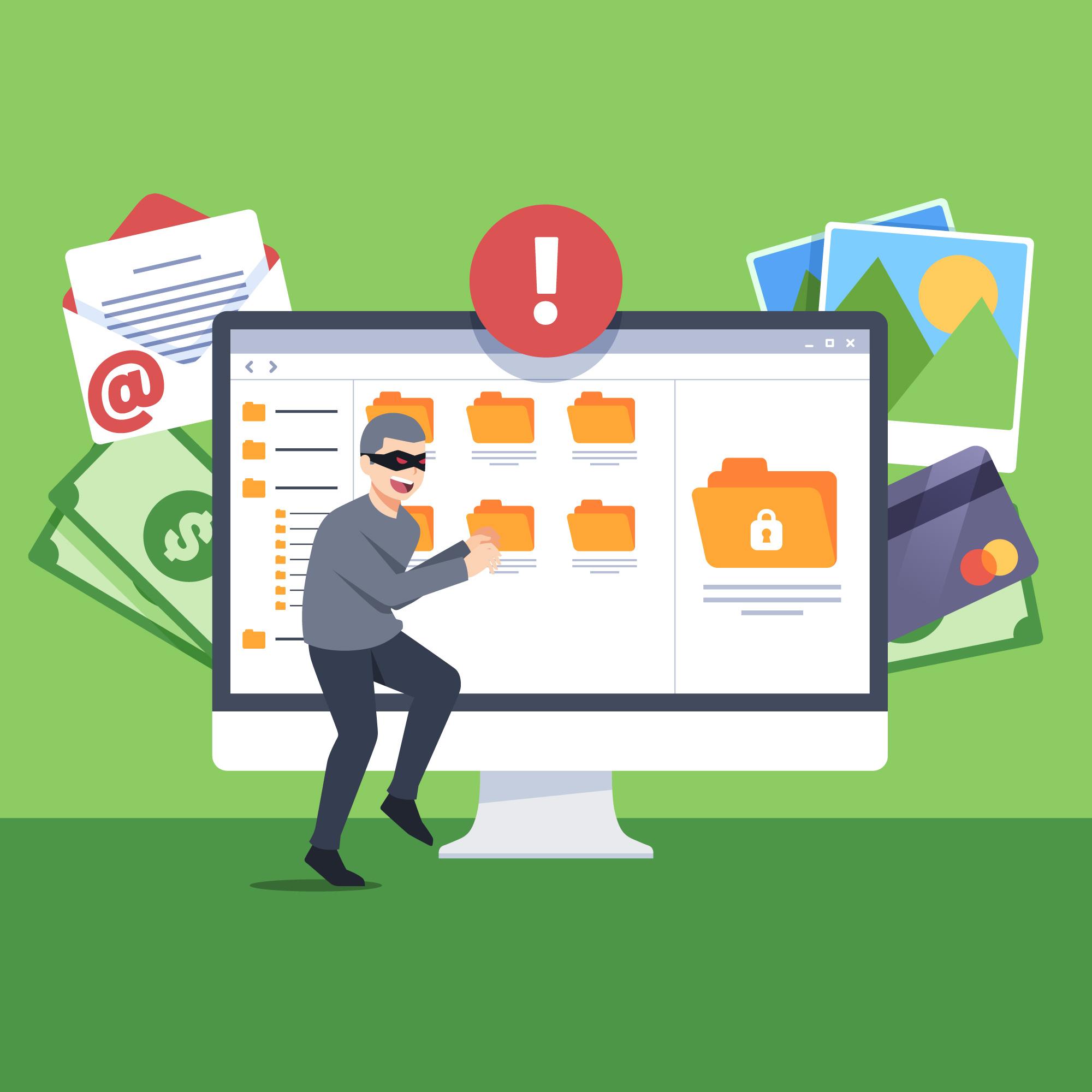Table of Content
Try Vizitor for Free!

Fri, Feb 7, 2025
Read in 9 minutes
Cybersecurity or Digital Security in workplaces have become an important yet critical requirement for modern workspaces.
Workplaces today are more connected than ever—smart devices, cloud systems, and automated workflows have revolutionized efficiency. But with this digital transformation comes an invisible danger: security risks that can compromise data, disrupt operations, and even threaten business survival.
It’s not just cybercriminals or hackers sitting behind screens; sometimes, the biggest threats walk right through the office doors. An unverified visitor, a misplaced document, or an unattended device—a single lapse can open the gates to security breaches.
The World Economic Forum’s “Global Cybersecurity Outlook 2025” underscores that geopolitical tensions and intricate supply chains are amplifying cyber risks for businesses and governments alike.
In an era where information is the backbone of every organization, the question isn’t just about staying productive but about staying protected.
The question is no longer if a security breach will happen but when.
Are workplaces prepared to handle these risks? And more importantly, how can they prevent them in the first place?
With cybercrime damages projected to reach $10.5 trillion annually by 2025, businesses can no longer afford to overlook workplace security. From unauthorized access to data breaches, every organization must strengthen its digital defenses—and that starts with better visitor management, compliance, and access control.
In this blog, we will explore the top digital security risks at workplaces and how businesses can mitigate them using Vizitor’s visitor management Solutions and workplace security solutions.
What do you mean by Digital or Cybersecurity Risks?
Cybersecurity risks refer to potential threats, vulnerabilities, or attacks that can compromise an organization’s digital assets, systems, or data. These risks include hacking, malware, phishing, data breaches, and insider threats, leading to financial loss, reputational damage, and legal consequences.
What are some Hidden Impacts of Cyber or Digital Security Risks on Businesses?
Cybersecurity risks don’t just cause financial loss—they also impact business reputation, employee trust, and customer confidence. A single data breach can:
Break Customer Trust – 81% of consumers say they would stop engaging with a brand after a data breach.
Disrupt Business Operations – Ransomware attacks can shut down entire systems, halting productivity.
Increase Legal Liabilities – Non-compliance with GDPR or HIPAA can result in hefty fines and lawsuits.
Expose Sensitive Information – Leaked employee or client data can lead to identity theft and fraud.
Major Digital Security Risks in Workplaces and What Solutions Can Overcome Them?
1.Phishing & Social Engineering Attacks
Cybercriminals often exploit human psychology rather than technical vulnerabilities. Phishing emails, fake phone calls, and impersonation scams trick employees into revealing sensitive information or login credentials. In 2023, 91% of cyberattacks started with a phishing attempt.
Research indicates that globally, approximately 2.9 out of every 1,000 employees click on phishing links each month.
In Australia, the rate is notably higher, with 5 out of every 1,000 employees falling victim to phishing attacks monthly.
What could be the Solution:
✔ Conduct cybersecurity awareness training to help employees recognize phishing scams.
✔ Enable email filtering systems to detect and block malicious emails.
✔ Implement multi-factor authentication (MFA) to prevent unauthorized logins.
2. Unauthorized Access to Office Premises
Unauthorized access is one of the biggest security risks workplaces face today. Studies show that organizations suffer an average of $5.85 million in damages annually due to breaches caused by unverified individuals entering restricted areas.
Real-Life Case: In 2022, a global tech company experienced a major data breach when a former employee, whose access should have been revoked, walked in using an old access card. Without raising suspicion, he accessed confidential files, leading to severe financial and reputational losses.
How to Prevent This:
A Visitor Management System (VMS) acts as the first line of defense by:
✔ Digital check-ins to verify visitors, contractors, and employees.
✔ Facial recognition & badge issuance to prevent unauthorized entry.
3. Unsecured Devices
Employees often use personal devices or unauthorized software for work, creating security loopholes. These devices may lack proper security updates, exposing company data to cyber threats.
What could be the Solution:
✔ Enforce a Bring Your Own Device (BYOD) policy with strict security guidelines.
✔ Install Mobile Device Management (MDM) software to monitor and secure workplace devices.
✔ Restrict the use of unauthorized applications and cloud storage services.
4. Ransomware & Malware Attacks
Ransomware attacks can lock critical company data and demand payment for its release. Malware can also spread through email attachments, infected USB drives, or compromised websites. In 2023, the average ransom payment was $1.54 million.
What could be the Solution:
✔ Use endpoint protection software to detect and block malware.
✔ Train employees to avoid clicking on unknown links or downloading unverified files.
✔ Regularly backup all business-critical data to a secure cloud or offline storage.
5. Lack of Compliance & Regulatory Violations
In today’s digital world, organizations are required to follow strict data protection laws like GDPR, HIPAA, and ISO 27001 to ensure customer and business data is handled securely.
However, many companies fail to meet these compliance standards due to lack of awareness, outdated policies, or poor implementation, exposing them to hefty fines, legal consequences, and reputational damage.
In 2023, a multinational healthcare company was fined $1.25 million for failing to properly secure patient records, violating HIPAA regulations. Similarly, companies operating in the European Union have faced fines exceeding €20 million for GDPR non-compliance, proving that regulatory violations are not just a legal issue but a financial and trust-breaking disaster.
How to Ensure Compliance:
✔ Conduct Regular Security Audits: Perform frequent compliance checks and risk assessments to identify gaps in security policies and ensure they align with industry regulations.
✔ Employee Training & Awareness: Train staff on data protection laws, safe data handling, and security best practices to minimize risks caused by human errors.
✔ Implement Automated Compliance Tools: Use compliance management software to track, monitor, and enforce security policies across all digital systems.
✔ Data Encryption & Secure Storage: Ensure sensitive business and customer data is encrypted and stored in compliant, secure environments to prevent unauthorized access.
Also explore: 4 Common Compliance Standards Businesses Should Know About
6. Insider Threats & Data Theft
One of the most overlooked cybersecurity risks in workplaces is insider threats, which account for 34% of all security incidents.
These threats often come from disgruntled employees, former staff members, or third-party contractors who have access to sensitive company data.
Unlike external cyber threats, insider risks are harder to detect because the perpetrators already have authorized access to systems, networks, or physical premises.
How Insider Threats Occur:
- Disgruntled employees may leak company secrets for revenge or financial gain.
- Former employees may still have active credentials or physical access cards if offboarding procedures are weak.
- Unmonitored third-party contractors (IT vendors, maintenance workers, temporary staff) can access and misuse company data.
- Lack of access controls makes it easy for insiders to download, copy, or transfer sensitive files without detection.
How to Prevent Insider Threats & Data Theft:
✔ Implement a Visitor Management System (VMS): Link access control systems with a VMS to ensure that only authorized employees and visitors can enter the workplace.
✔ Use Temporary Access Badges for Contractors: Provide time-limited access to third-party contractors and vendors, ensuring their access expires immediately after their work hours.
✔ Monitor Visitor Logs & Check-in/Check-out Data: Maintain detailed visitor logs and real-time monitoring dashboards to track who enters and exits sensitive office areas.
By enforcing strict access controls, real-time monitoring, and data security measures, organizations can minimize insider threats and prevent costly data theft incidents.
7. Physical Security Breaches Through Social Engineering
Hackers manipulate receptionists, security guards, or employees to gain access.
Take an Example: In 2022, a hacker impersonated an IT technician and gained entry into a bank’s server room, causing a $12 million breach.
What could be the Solution:
✔ Automate visitor verification with biometric authentication.
✔ Train employees to identify phishing & social engineering tactics.
✔ Install CCTV integration with a Visitor Management System for real-time alerts.
Cybersecurity Tips for Employees: Building Workplace Security Awareness
Employees play a crucial role in maintaining workplace cybersecurity. A single mistake, like clicking on a phishing email, can lead to data breaches, ransomware attacks, or financial losses. Here are key cybersecurity tips to enhance workplace security awareness:
✔ Use Strong Passwords & Multi-Factor Authentication (MFA) – Avoid using the same password for multiple accounts and enable MFA for added protection.
✔ Beware of Phishing Scams – Do not click on suspicious links or share personal information via email.
✔ Secure Workplace Devices – Always lock your computer when leaving your desk and update software regularly.
✔ Limit Access to Sensitive Data – Follow role-based access controls and avoid sharing
Some Amazing Statistics on Impact of Digital Security Measures
- 75% of businesses using a visitor management system reported fewer unauthorized access incidents.
- A US-based financial firm reduced cyber breach risks by 60% after integrating a VMS with network access control.
- A manufacturing company saved $100,000/year by eliminating manual visitor logbooks and reducing compliance fines.
How a Visitor Management System Strengthens Workplace Cybersecurity
Cybersecurity is often associated with firewalls, encryption, and anti-virus software, but physical security plays an equally critical role in protecting an organization’s digital assets.
Unauthorized access to office premises can lead to serious cyber threats, including data theft, system breaches, and compliance violations.
A Visitor Management System (VMS) Like Vizitor acts as a first line of defense, ensuring that only authorized personnel can enter the workplace while enhancing cybersecurity measures.
Key Benefits of Visitor Management Systems:
✔ Prevents Unauthorized Access: Digital check-ins, access control integration, and visitor tracking.
✔ Reduces Insider Threats: Temporary badges, role-based access, and real-time monitoring.
✔ Ensures Compliance: Automated reports for GDPR, HIPAA, and ISO 27001 audits.
✔ Stops Social Engineering Attacks: ID verification and real-time security alerts.
✔ Secures Wi-Fi & IoT Networks: Restricts visitor access to corporate systems.
✓Enhances Threat Detection: Facial recognition, instant alerts, and emergency response tracking.
✓Uses QR-based check-ins, biometric authentication, or OTP verification.
Choosing the Right Visitor Management System for Digital Security
When selecting a Visitor Management System, ensure it has:
✔ Contactless check-in & biometric authentication
✔ Cloud-based visitor logs with encryption
✔ Integration with office management & security systems
✔ Customizable compliance reports & visitor screening
One such powerful system is Vizitor – a smart, AI-driven visitor management solution that ensures workplaces remain secure, compliant, and digitally protected.
Secure Your Workplace with Vizitor
Cybersecurity risks are evolving, and protecting your workplace requires more than just firewalls and antivirus software. Unauthorized access, insider threats, and compliance violations can put your business at risk.
Protect your workplace from security breaches today! Book a free demo with Vizitor and take control of your workplace security.
Get Started with Vizitor!







